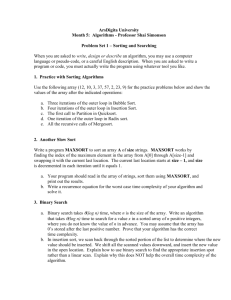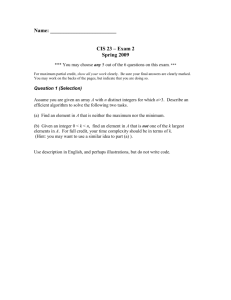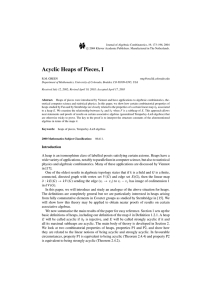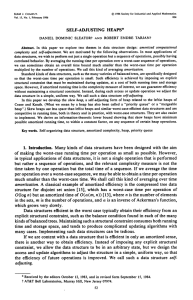heap
advertisement
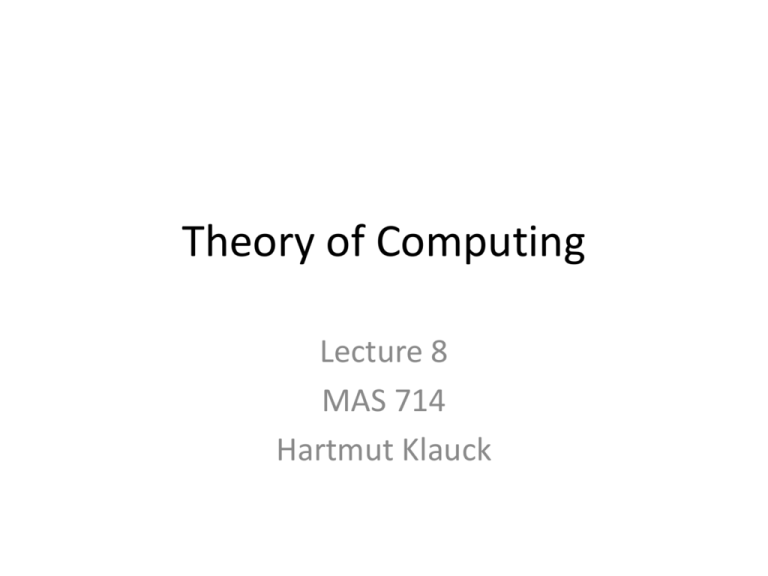
Theory of Computing Lecture 8 MAS 714 Hartmut Klauck Data Structure: Priority Queue • Store (up to) n elements and their keys (keys are numbers) • Operations: – ExtractMin: Get (and remove) the element with minimum key – DecreaseKey(v,x): replace key(v) with a smaller value x – Initialize – Insert(v,key(v)) – Test for emptiness Priority Queues • We will show how to implement a priority queue with time O(log n) for all operations • This leads to total time O((n+m) log n) for the Dijkstra algorithm • Slightly suboptimal : we would like O(n log n + m) – Much more difficult to achieve Heaps • We will implement a priority queue with a heap • Heaps can also be used for sorting! – Heapsort: Insert all elements, ExtractMin until empty • If all operations take time log n we have sorting in time O(n log n) Heaps • A heap is an array of length n – can hold at most n elements • The elements in the array are not sorted by keys, but their order has the heap-property • Namely, they can be viewed as a tree, in which parents are smaller than their children – ExtractMin is easy (at the root) – Unfortunately we need to work to maintain the heap-property after removing the root Heaps • Keys in a heap are arranged as a full binary tree where the last level is filled from the left up to some point • Example: Heaps • Heap property: – Element in cell i is smaller than elements in cells 2i and 2i+1 • Example: Tree Array Heaps • Besides the array storing the keys we also keep a counter SIZE that tells us how many keys are in H – in cells 1…SIZE Simple Procedures for Heaps • Initialize: – Declare the array H of correct length n – Set SIZE to 0 • Test for Empty: – Check SIZE • FindMin: – Minimum is in H[1] • All this in time O(1) Simple Procedures for Heaps • Parent(i) is b i/2c • LeftChild(i) is 2i • Rightchild(i) is 2i+1 Procedures for Heaps • Suppose we remove the root, and replace it with the rightmost element of the heap • Now we still have a tree, but we (probably) violate the heap property at some vertex i, i.e., H[i]>H[2i] or H[i]>]H[2i+1] • The procedure Heapify(i) will fix this • Heapify(i) assumes that the subtrees below i are correct heaps, but there is a (possible) violation at i • And no other violations in H (i.e., above i) Procedures for Heaps • Heapify(i) – l=LeftChild(i), r=Rightchild(i) – If l·SIZE and H[l]<H[i] Smallest=l else Smallest=i – If r·SIZE and H[r]<H[Smallest] Smallest=r – If Smallesti • Swap H[i] and H[Smallest] • Heapify(Smallest) Heapify • Running Time: – A heap with SIZE=n has depth at most log n – Running time is dominated by the number of recursive calls – Each call leads to a subheap that is 1 level shallower – Time O( log n) Procedures for Heaps • ExtractMin(): – Return H[1] – H[1]=H[SIZE] – SIZE=SIZE-1 – Heapify(1) • Time is O(log n) Procedures for Heaps • DecreaseKey(i,key) – If H[i]<key return error – H[i]=key \\Now parent(i) might violate heap property – While i>1 and H[parent(i)]>H[i] • Swap H[parent(i)] and H[i], i=parent(i) \\Move the element towards the root • Time is O(log n) Procedures for Heaps • Insert(key): – SIZE=SIZE+1 – H[SIZE]=1 – DecreaseKey(SIZE,key) • Time is O(log n) Note for Dijkstra • DecreaseKey(i,x) works on the vertex that is stored in position i in the heap • But we want to decrease the key for vertex v! • We need to remember the position of all v in the heap H • Keep an array pos[1...n] – Whenever we move a vertex in H we need to change pos The single-source shortest-path problem with negative edge weights • Graph G, weight function W, start vertex s • Output: a bit indicating if there is a negative cycle reachable from s AND (if not) the shortest paths from s to all v Bellman-Ford Algorithm • Initialize: d(s)=0, (s)=s, d(v)=1, (v)=NIL for other v • For i=1 to n-1: – Relax all edges (u,v) • For all (u,v): if d(v)>d(u)+W(u,v) then output: „negative cycle!“ • Remark: d(v) and (v) contain distance from s and predecessor in a shortest path tree Running time • Running time is O(nm) – n-1 times relax all m edges Correctness • Assume that no cycle of negative length is reachable from s • Theorem: After n-1 iterations of the for-loop we have d(v)=(s,v) for all v. • Lemma: Let v0,…,vk be a shortest path from s=v0 to vk. Relax edges (v0,v1)….(vk-1,vk) successively. Then d(vk)=(s,vk). This holds regardless of other relaxations performed. Correctness • Proof of the theorem: – – – – – Let v denote a reachable vertex Let s, …,v be a shortest path with k edges k· n-1 can be assumed (why?) In every iteration all edges are relaxed By the lemma d(v) is correct after k· n-1 iterations • For all unreachable vertices we have d(v)=1 at all times • To show: the algorithm decides the existence of negative cycles correctly • No neg. cycle present/reachable: for all edges (u,v): – d(v)=(s,v)·(s,u)+W(u,v)=d(u)+W(u,v), pass test Correctness • If a negative cycle exists: – Let v0,…,vk be a (reachable) path with negative length and v0=vk – Assume the algorithm does NOT stop with error message, then • d(vi)·d(vi-1)+W(vi-1,vi) for all i=1...k • Hence Correctness • v0=vk, so • d(vi)< 1 in the end for all reachable vertices, hence The Lemma Lemma: Let v0,…,vk be a shortest path from s=v0 to vk. Relax edges (v0,v1)….(vk-1,vk) successively. Then d(vk)=(s,vk). This holds regardless of other relaxations performed. Proof: By induction. After relaxing (vi-1, vi) the value d(vi) is correct. Base: i=0, d(v0)=d(s)=0 is correct. Assume d(vi-1) correct. According to an earlier observation after relaxing (vi-1,vi) also d(vi) correct. Once d(v) is correct, the value stays correct. d(v) is always an upper bound Application of Bellman Ford • Graph is a distributed network – vertices are processors that can communicate via edges • We look for distance/shortest path of vertices from s • Computation can be performed in a distributed way, without – global control – global knowledge about the network • Dijkstra needs global knowledge • Running time: n-1 phases, vertices compute (in parallel)







